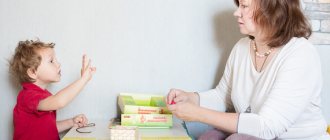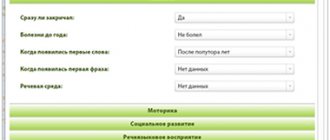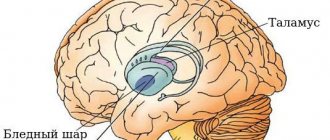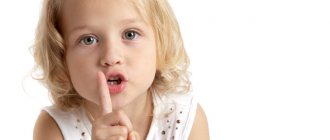Features of speech therapy work with autistic children
Elena Safonova
Features of speech therapy work with autistic children
MKDOU Bogucharsky combined kindergarten "Rodnichok"
Report
(using computer presentation)
«Features of speech therapy work with autistic children».
Compiled by:
Teacher speech therapist
Safonova Elena Gennadievna
Boguchar 2017
Target:
• Definition of autism .
• Practical introduction to the features of speech therapy work with autistic children .
• Clarification of difficulties in the work of a speech therapist with a child with Kanner syndrome
• Familiarization with the stages of a speech therapist's work .
Equipment: multimedia installation, computer presentation.
What is autism ?
• Autism is a disorder of brain development characterized by severe and pervasive deficits in social interaction and communication, as well as restricted interests and repetitive behaviors. All of these signs begin to appear before the age of three. Similar conditions with milder signs and symptoms are autism spectrum . Autism is a severe developmental disorder that lasts throughout life.
of psychological and pedagogical support for children with autism continues to be an urgent problem in domestic correctional pedagogy . The fact that in Russia society is gradually beginning to recognize the need for education and social adaptation of children suffering from complex forms of developmental disorders forces specialists to think more and more about how to build a system of work with this population. Autism syndrome is often part of a complex defect, where it plays a role no less important than other disorders, for example, intellectual, speech, and motor impairment. This is due to the fact that communication disorders as such are the main obstacle to the development of all mental functions, even with their potential preservation. We will focus on some aspects of working with children with severe and complicated forms of autism .
Autistic have a wide range of speech disorders, and very often it the speech therapist who is the person who must conduct an initial diagnosis of the development of autistic child and coordinate the family for further action.
Let us recall that the main symptoms of delay and distortion of speech development vary depending on the autism .
Thus, in children of the first group we observe an almost complete absence of external speech. Rare words or short phrases uttered by a child at the height of passion suggest that he understands speech at least partially.
The speech of children in the second group is characterized by echolalia; there is also a small set of stereotypical short phrases, either received by the child in some affective situation. Children of the second group have stereotypical requests and appeals in which the verb is used in the infinitive ( “Drink juice”
,
“Give cookies
,” and the child speaks about himself in the second or third person (
“Sasha will draw”
).
But often such children prefer to address and ask not in the usual way, but by shouting, or simply try to lead an adult to the right place and poke his hand into the object of interest to them.
Children of the third group have extensive literary speech, but are almost incapable of dialogue ; they do not hear their interlocutor, although they quote entire pages of their favorite books or discuss their favorite topic.
In a child of the fourth group, we encounter quiet, unclear speech and echolalia, sometimes delayed in time. Such a child asks and addresses, as a rule, with the help of speech, but retelling is difficult for him.
When working with children diagnosed with ASD , RDA, one cannot talk only about corrective influence, as everyone is accustomed to understanding the work of a speech therapist . Correction means correction; but it is impossible to correct sound pronunciation or begin work on improving lexical and grammatical skills if the communicative features of the child’s speech .
The main tasks of speech therapy work for autism :
• establishing emotional contact with the child;
• finding out the child’s level of contact with a stranger (i.e. speech therapist )
• primary examination of speech (its understanding)
;
• speech understanding training;
• teaching expressive speech.
The speech therapist carries out the first step of primary diagnosis - monitoring the child. This method makes it possible to formulate initial ideas about the object of observation or check the initial assumptions associated with it. Therefore, the observation method plays a decisive role in the search for differential diagnostic criteria.
In order to clarify the picture of the child’s holistic development, a speech therapist can use a diagnostic card developed by K. S. Lebedinskaya and O. S. Nikolskaya. When exploring the sphere of communication, the speech therapist needs to pay attention to visual contact, features of the revitalization complex , recognition of loved ones, the formation of attachment to loved ones, reaction to a new person, contact with children , attitude to physical contact, reaction to verbal addresses, lack of response to a name, selectivity responses to speech, lack of adequate gesture, behavior alone, attitude towards the environment, “lack” of differentiation between animate and inanimate.
Most speech therapy techniques remain unsuited for diagnosing the level of speech development of children with autism , when the main attention should be paid to examining the understanding of speech and its communicative use. can a description of speech therapy examination and correctional work built on the methodological foundations of applied behavioral analysis in S. S. Morozova in the section “TRAINING SPEECH AND COMMUNICATION SKILLS”
.
Directions for speech therapy correction for autism .
1. Examination of speech understanding (impressive speech)
.
First of all, the child’s understanding of speech is examined in a spontaneous situation. They study whether the child understands statements that contain words that are affectively significant for him. What is meant? By observation or in conversation with parents, they find out what the child loves, what is especially significant .
Then they check whether the child follows verbal instructions: a) in the context of what is happening; b) outside the context of what is happening. In the first case, the child is asked to do something in line with what he is doing. For example, if he is playing with a railroad, you can say: “Put the carriage on the rails.”
.
In the second case, the child is given instructions that are not related to what he is doing, for example: “Come here.”
,
“Give me a cube,”
etc. When assessing understanding of instructions, assistance
(for example, gestures)
to obtain more accurate information. Instructions must be presented in different contexts and situations.
If the child's behavior changes in a visible way - for example, he turns his head towards the speaker or approaches him, we can assume that he has at least partially understood the statement.
During observation of the child's spontaneous behavior, various vocalizations and sounds of extralaryngeal origin are recorded. Attention is drawn to the presence of spontaneous imitation of various sounds and words; expression of demands or refusals; echolalia is recorded; The child’s own spontaneous statements are noted.
After observing the child, which may be repeated, the speech therapist begins to build a work . To do this, he draws up an individual program, where he records his stages of work .
2. Development of understanding of speech (emotional and semantic commentary, plot drawing)
.
A speech therapist involved in the psychological and pedagogical support of a child with autism must learn to provide emotional and semantic commentary as a necessary element of classes.
This is the only adequate way to ensure that the child is included in reality, aware of what is happening around him, and understands speech. Before starting training, it is necessary to analyze the entire range of speech skills that the child has. Training begins with the skills that are easiest for him; the degree of difficulty is determined individually.
Necessary prerequisites for starting training are the partial formation of “learning behavior”
, following simple instructions (including
“Give”
and
“Show”
). These instructions will be needed to help you learn to understand the names of objects.
3. Development of the ability to actively use speech (disinhibition of external speech)
.
• With autism, more than with any other disorder, there is a noticeable difference between what a child understands and what he can say. But the reason here is completely special : this is the absence or decrease in speech initiative, which we must restore and develop. The most difficult, time-consuming and least predictable in terms of pace and results is working with “non-speaking”
children (the first group or a mixed case with signs of both the first and second groups).
4. Disinhibition of speech in such children occurs simultaneously in three directions:
• Provoking involuntary imitation of the action, facial expressions, and intonation of an adult .
• Such involuntary imitation can become a prerequisite for voluntary imitation - auditory, and then verbal.
5. Provoking the child to echolalia and involuntary verbal reactions.
• At the right moment in the game, when you have managed to focus the child’s attention on your face, you can, for example, make a grimace of surprise, of course, with a suitable comment. In general, it is important for us to ensure that a non-speaking child looks at our face and mouth as often as possible at the very moment when we say something. We achieve this with the help of physical rhythms, the rhythms of the child’s movement. This work takes a lot of time. In most cases, this lasts up to six months.
6. Formation of expressive (active)
speeches
• This stage begins with learning the skill of imitating sounds and articulatory movements.
• Sounds and articulatory movements should be selected individually; it is preferable to use those that occur in the child’s spontaneous behavior. Examples of articulatory movements: open the mouth, show the tongue, brush the teeth, puff out the cheeks, blow, etc.
A study of the results obtained from the work of practicing teachers showed that special speech therapy is one of the most important in the correction of autistic behavior , emotional and mental underdevelopment in children with early childhood autism .
List of used literature.
1. Morozova S.S. Autism : correctional work for severe and complicated forms. — M.: Humanitarian. ed. VLADOS center, 2007.
2. Nurieva L. G. Speech development in autistic children . - M.: Terevinf, 2006.
3. Lebedinskaya K. S., Nikolskaya O. S. Diagnostic card. A study of a child in the first two years of life who is suspected of having early childhood autism .
Integrated individual speech therapy session with a child with ASD
Topic: Automation of vowel sounds based on the lexical topic “Wintering Birds” Goal: To consolidate knowledge about vowel letters and the sounds they represent; correct pronunciation of vowel sounds. Tasks: Corr.-image: Clarify the correct pronunciation of vowel sounds of the 1st row. Learn to correlate sounds with color symbols. To form ideas about wintering birds, their lifestyle and diet. Corr.- times: Form self-control of speech through oral, tactile-vibration and acoustic control; develop understanding of speech, the ability to listen attentively to the speech therapist’s speech; Corr. – vosp: To cultivate a desire to help birds in difficult winter conditions. Equipment: tape recorder, magnetic board, pictures of birds, cut-out pictures, “Fun articulation gymnastics” by Nishchev, teaching aid “Pyramid”, table of vowel sounds, “dry pool”, magnetic letters, mitten (breathing), house (manual) of vowels sounds, pointer. Progress of the lesson: Stages of the lesson Time, min Speech therapist Child Organizational moment
(Message of the topic of the lesson) 3 Hello, Fedor! I'm very glad to see you in class. Fedya, today we will have a slightly unusual activity. We are not alone. Let's say hello. What time of year is it now? - That's right, winter! Winter, frosty, snowy, cold. It's a magical time of year. It's winter outside, and a snowman came to class. Say hello, hug the snowman. The snowman invites you for a winter walk. Fedya, do you hear the chirping, singing? (music). What it is? Look around, look, the birds have flown to us. Today we will get acquainted with wintering birds. These are Sparrow, Tit, Bullfinch, Crow, Woodpecker. These birds remain for the winter; we call them “wintering birds.” - Is it difficult for them to live in winter, in such frosts? All the blades of grass, flowers, and berries were under the snow. It is difficult for birds in the forest to find food. Is there any way we can help them? You can build feeders. Birds fly closer to people so that they can take care of them, warm them, and feed them. Let's invite our birds to the feeder. The snowman invites you to play with the birds. Let's help our birds together with the snowman this winter. The child says hello and goes to class. - looks at the pictures and chooses the correct one. Collects birds. Breathing exercises
1-2 To go to the forest, you need to get dressed. We put on mittens. There are snowflakes on the mittens, let's blow them away. Do it right, try hard. Inhale through your nose and exhale through your mouth. Keep 1 ring. Performs breathing exercises. Articulation gymnastics
2 It’s so frosty in the winter forest, let’s rub our cheeks and warm ourselves up. The snowman offers to do a fun exercise for the tongue: (Hippopotamus, proboscis, smile, hamster,..) Well done, you completed the task correctly, and for this you get a ring. Performed by Artik. gymnastics Work with vowel sounds
3 Let's go further, look, there is a big snowdrift ahead, and there is something in the snow. Oh, what is this? - yes, these are letters. What letter is this? - This is the letter “A”. We read and write letters, and we pronounce and hear sounds. Let's remember what symbols we use to represent sounds and letters. When we pronounce the sound (A) our mouth is wide open…. There is a lot of snow in the snowman’s yard, let’s see what’s hidden there: (finds letters, pronounces). Let's put our sounds in the house. A O U E I S
Well done! All sounds have found their home. The snowman hands you 3 rings, finds letters in a dry pool, pronounces them, puts them on the table with vowel sounds, and sings them. Finger gymnastics
1 Our snowman is a little bored, let's cheer him up and play with our fingers together. Winter birds I feed all the birds in winter: Pigeons, crows, tits, sparrows and bullfinches - (bend and straighten fingers, listing the birds) Here is the feeder by the door. (point to the feeder with one hand) I’ll give them rolls, millet porridge, I’ll give them grains, seeds. And I’ll give the tit some lard, (they bend and straighten their fingers, counting the food) Let her peck at it. (we imitate the movements with our fingers gathered into a pinch). We played very well with our fingers. Hold the next ring. Performs finger gymnastics Visual gymnastics
1 Fedya, our snowman’s eyes are tired, and are yours tired? Then let's do some exercises, and the titmouse will help us with this! Performs eye exercises. Isolating a vowel from other letters
2-3 How good it felt for our eyes, look, the birds have also prepared a task for you and for the snowman: you need to circle the letters A, I, U: It stands out among other letters, circled in red. “Recognize the bird” - cut-out pictures
3 Look, the bird flew and dropped a letter for you, open it and see what’s inside: You need to make a portrait of each bird. Collects cut-out pictures (4 pieces) Physical education minute
1 Our legs are tired of sitting still, let's play: "Bullfinches" Here on the branches, look, Bullfinches in red T-shirts, Fluffed up their feathers, Basking in the sun, Turning their heads, wanting to fly away. Shoo-shoo! Let's fly away! Behind the blizzard! Behind the blizzard!
Performs physical education
3 How many rings do you already have? While we were playing, the birds got hungry. At the beginning of the lesson, we talked about how birds need help in winter. Let's give our birds a treat
Feeds the birds. Summary Reflection 2
19-20 min Let's remember what we did in class today. Look at the rings. Well done, you completed all the tasks. Look what a beautiful pyramid you have made. The snowman liked how you handled the tasks, he brought you medals, choose the one you like best. Answers questions, chooses a smiley-mood.
Conducts classes and receptions at CNIR:
| Speech therapy/defectological diagnostics, 60 min. | Sign up |
| Speech therapy/defectology session for problems with sound pronunciation (except for dysarthria), 60 min. | Sign up |
| Speech therapy/defectology session for dysarthria (including speech therapy massage), 60 min. | Sign up |
| Speech therapy/defectology session for mental retardation, mental retardation, mental retardation, 60 min. | Sign up |
| Speech therapy massage, 60 min. | Sign up |
| Speech therapy training for parents with children (ability to communicate and play with children from 0 to 5 years), 60 min. | Sign up |
| Speech therapy/defectological massage in the structure of a correctional lesson, 60 min. | Sign up |






